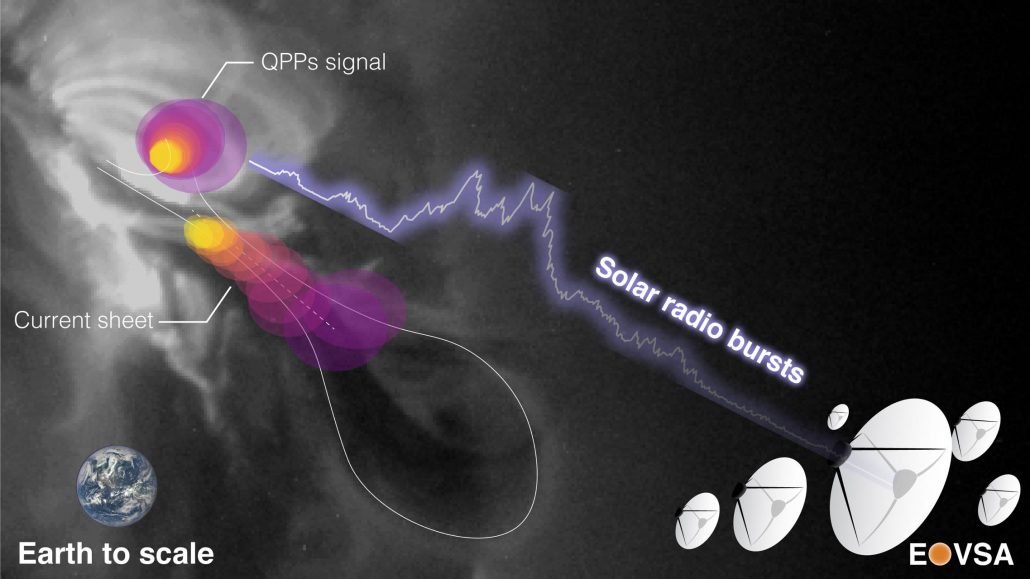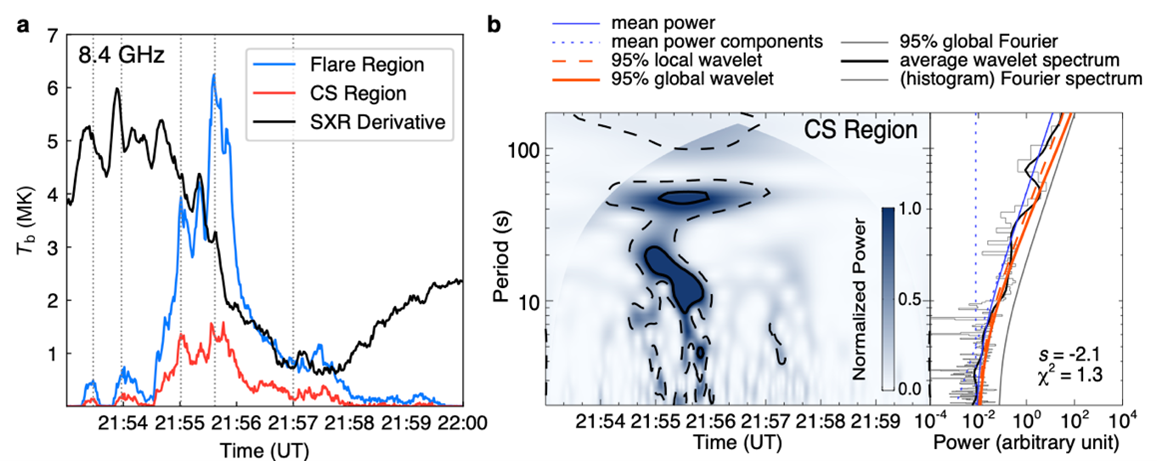Quasi-periodic pulsations (QPPs; also known as quasi-periodic oscillations, i.e., QPOs) are phenomena that electromagnetic emissions vary quasi-periodically with time. They appear in celestial transient events with different temporal/spatial scales, such as stellar flares, gamma ray bursts and fast radio bursts, and etc.
The Sun is a normal but the closest star from us, where flares with QPPs appear frequently (e.g. Zimovets et al. 2021 as a review). In the standard flare model, magnetic reconnection plays an important role in releasing energy from the coronal magnetic field, ejecting plasmoid, and accelerating electrons. After escaping from reconnection region, those energetic electrons propagating along magnetic field lines will induce microwave emissions by gyrosynchrotron mechanism. Thus, the temporal variation of microwave emissions is closely related to the process of electron acceleration. And once the magnetic reconnection happens quasi-periodically, the electron acceleration will also be quasi-periodic and QPPs will be generated.
Besides, it is also prevalently thought that magnetohydrodynamic (MHD) waves could also modulate some plasma parameters such as density, temperature, and magnetic field strength, and etc., which may reshape electromagnetic radiations in a periodic form. However, the above two mechanisms are still in debate for a long time, because direct imaging observations on microwave or HXR sources, which are highly related to energetic electrons, at the energy release site (reconnection current sheet) are still absent. In the recent paper by Kou et al, 2022 , we report the imaging observation of microwave QPPs at the flare current sheet region for the first time, by using the microwave radioheliograph Expanded Owens Valley Solar Array (EOVSA) with the state-of-art spectral-imaging capability (Chen et al, 2020).

Figure 1. Microwave emissions from the flare. The upper group is from flaring loops, and the lower group extends along reconnection current sheet. The background is an EUV image at 211 A. The gold curve represents the temporal variation curve of current sheet source at 8.4 GHz.

Figure 2. Temporal variation curves of microwave sources at 8.4 GHz (left) and the Wavelet Analysis result (right).
It has been found that the microwave sources at the current sheet are much weaker than those at flaring loops, and thus tend to be overwhelmed by the background noise. Thanks to EOVSA’s high dynamic range and spectral-imaging capability, the authors found that temporal variations of brightness temperatures and spectral indices (smaller spectral indices, i.e., harder spectra, correspond to higher non-thermal quality) of all those sources, no matter strong or weak, present similar quasi-periodicities. Moreover, a 2.5-dimensional MHD simulation further validates that magnetic islands generated in the current sheet modulate magnetic reconnection into a quasi-periodic form. All these results strongly support the scenario that quasi-periodic magnetic reconnection in the current sheet accelerates electrons quasi-periodically and then generates QPPs.
Based on the recent paper by Kou, Y., Cheng, X., Wang, Y. et al. “Microwave imaging of quasi-periodic pulsations at flare current sheet“, Nature Communications, 13, 7680 (2022). DOI: 10.1038/s41467-022-35377-0
References
Kou, Y., Cheng, X., Wang, Y. et al., Nature Commun. 13, 7680 (2022).
Zimovets, I. V. et al., Space Sci. Rev. 217, 66 (2021).
Chen, B. et al., Nat. Astronomy 4, 1140–1147 (2020).
